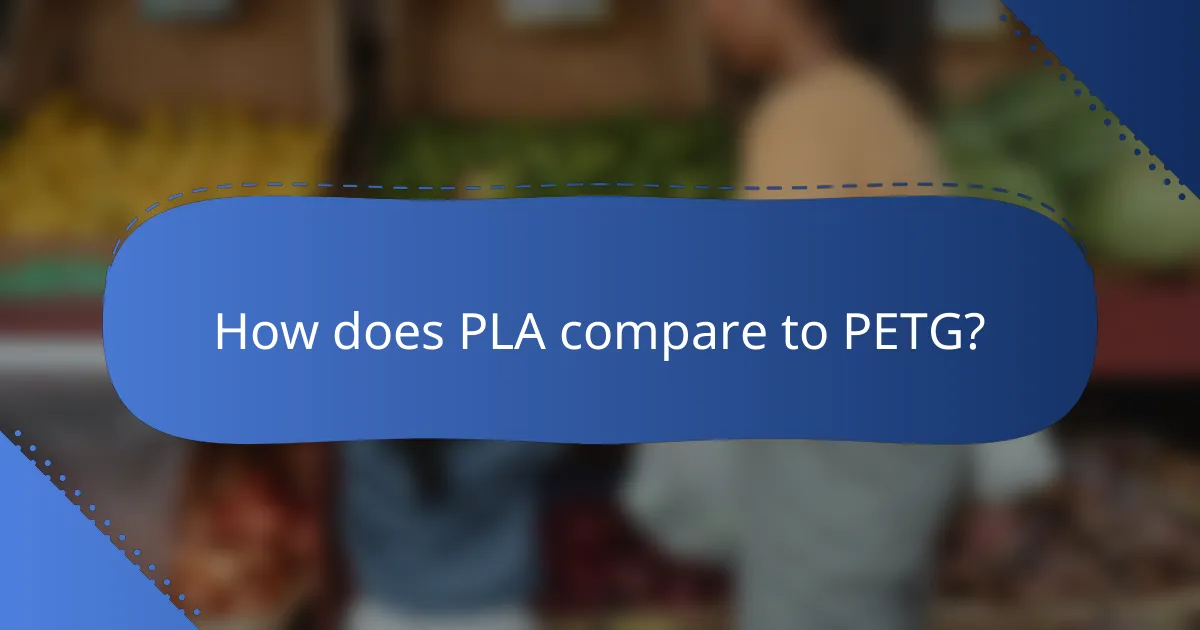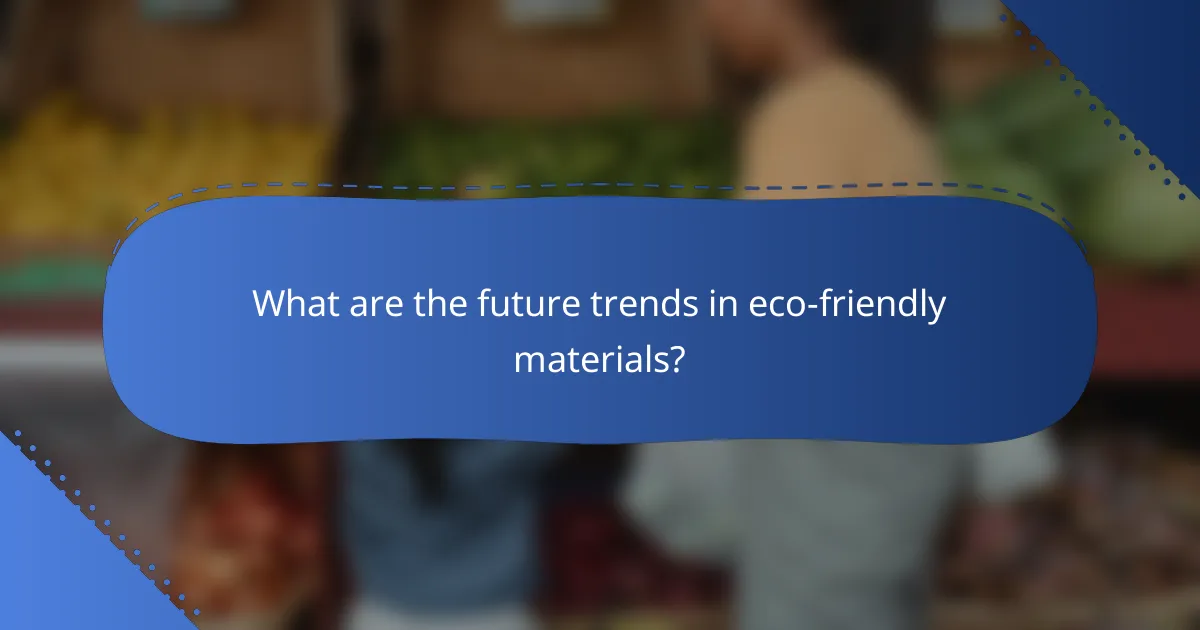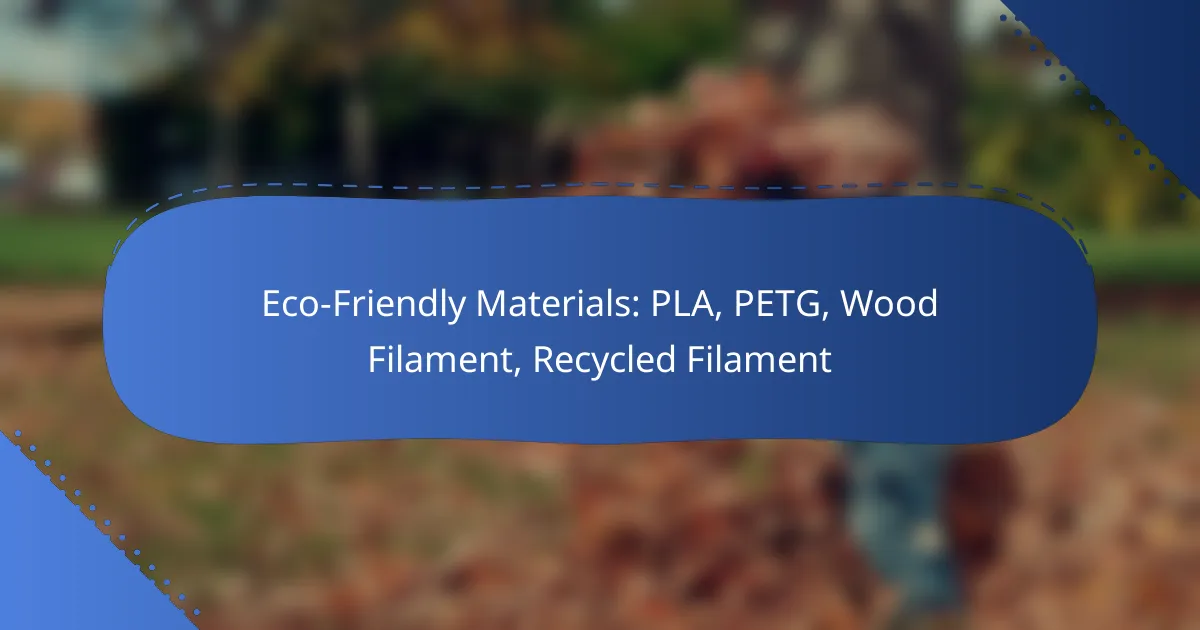Eco-friendly materials for 3D printing provide sustainable alternatives to traditional plastics, aiming to reduce environmental impact. Options like PLA, PETG, wood filament, and recycled filament not only enhance biodegradability and recyclability but also contribute to a lower carbon footprint, making them ideal choices for environmentally conscious creators.

What are eco-friendly materials for 3D printing?
Eco-friendly materials for 3D printing are sustainable alternatives to traditional plastics, designed to minimize environmental impact. These materials, such as PLA, PETG, wood filament, and recycled filament, offer various benefits in terms of biodegradability, recyclability, and reduced carbon footprint.
PLA (Polylactic Acid)
PLA is a biodegradable thermoplastic made from renewable resources like corn starch or sugarcane. It is popular in 3D printing due to its ease of use, low warping, and ability to produce high-quality prints.
When printing with PLA, maintain a nozzle temperature between 180°C and 220°C. While it is suitable for many applications, PLA is less heat-resistant than other materials, making it less ideal for functional parts exposed to high temperatures.
PETG (Polyethylene Terephthalate Glycol)
PETG is a strong, durable thermoplastic that combines the best properties of both PLA and ABS. It is known for its excellent impact resistance and flexibility, making it suitable for functional prototypes and end-use parts.
Printing with PETG requires a nozzle temperature of around 220°C to 250°C. It has a low tendency to warp, but proper bed adhesion is crucial. Consider using a heated bed set to about 70°C for optimal results.
Wood Filament
Wood filament is a composite material made from a blend of PLA and finely ground wood particles, offering a unique aesthetic and texture. It can create prints that resemble real wood, making it ideal for decorative items and artistic projects.
When using wood filament, print at temperatures between 180°C and 210°C. Be mindful of potential clogging issues due to the wood particles, and consider using a larger nozzle size to ensure smooth extrusion.
Recycled Filament
Recycled filament is produced from post-consumer plastic waste, making it an environmentally friendly option. This material helps reduce plastic waste while providing a similar performance to virgin plastics.
When printing with recycled filament, temperatures can vary based on the source material, but generally, a range of 200°C to 230°C is effective. Ensure the filament is dry before use to avoid printing issues related to moisture absorption.

How does PLA compare to PETG?
PLA and PETG are both popular materials in 3D printing, each with unique properties. PLA is biodegradable and easier to print, while PETG offers greater strength and flexibility, making it suitable for more demanding applications.
Biodegradability of PLA
PLA, or polylactic acid, is derived from renewable resources like corn starch, making it biodegradable under industrial composting conditions. It typically breaks down within a few months to a couple of years, depending on environmental factors such as temperature and moisture.
However, PLA requires specific conditions to decompose effectively, which may not be met in typical landfill environments. For those prioritizing sustainability, using PLA can significantly reduce plastic waste compared to traditional petroleum-based plastics.
Strength and Flexibility of PETG
PETG, or polyethylene terephthalate glycol-modified, is known for its excellent strength and flexibility, making it ideal for functional parts and prototypes. It is more impact-resistant than PLA, which can be crucial for applications that require durability.
While PETG is not biodegradable like PLA, it is recyclable and can be reused in various applications. When choosing between the two, consider the specific demands of your project, such as the need for toughness versus environmental impact.

What are the benefits of using wood filament?
Wood filament offers unique advantages, combining the aesthetics of wood with the functionality of 3D printing. It is popular for creating visually appealing and environmentally friendly products.
Natural Aesthetic Appeal
Wood filament provides a natural look and feel that mimics real wood, making it ideal for decorative items and functional pieces alike. Its texture and finish can resemble various types of wood, adding character to printed objects.
When printed, wood filament can showcase unique grain patterns and colors, enhancing the overall design. This makes it a favored choice for artisans and hobbyists looking to create custom pieces that stand out.
Biodegradable Properties
One of the key benefits of wood filament is its biodegradable nature, which makes it a more sustainable option compared to traditional plastics. It is often made from a blend of PLA and wood fibers, allowing it to break down more easily in composting environments.
Using biodegradable materials like wood filament can help reduce plastic waste, especially in applications where items are not intended for long-term use. However, proper disposal methods should be followed to ensure effective biodegradation.

How is recycled filament produced?
Recycled filament is produced by collecting plastic waste, processing it into small pellets, and then extruding those pellets into filament suitable for 3D printing. This process helps reduce plastic waste and promotes sustainability in manufacturing.
Process of Recycling Plastics
The recycling of plastics typically involves several key steps. First, plastic waste is sorted to separate different types of materials, such as PET and PLA. Next, the sorted plastics are cleaned to remove contaminants, then shredded into small pieces.
After shredding, the plastic pieces are melted and formed into pellets. These pellets can then be used to create new filament through an extrusion process, allowing for the production of high-quality recycled filament that can be used in various applications.
Environmental Impact Reduction
Using recycled filament significantly reduces environmental impact by minimizing the amount of plastic waste that ends up in landfills and oceans. It also lowers the demand for virgin plastic production, which is resource-intensive and contributes to greenhouse gas emissions.
Additionally, recycling plastics can save energy compared to producing new plastic from raw materials. For instance, recycling PET can save approximately 60% of the energy required to create new PET from petroleum. This energy savings translates into a reduction in carbon footprint, making recycled filament a more eco-friendly choice.

What are the best brands for eco-friendly filaments?
Some of the top brands for eco-friendly filaments include Filamentum, ColorFabb, and Proto-pasta. These companies offer a range of sustainable materials that cater to various 3D printing needs while minimizing environmental impact.
Filamentum
Filamentum is known for its high-quality PLA and PETG filaments, which are produced using renewable resources. Their materials are designed for excellent printability and durability, making them suitable for both hobbyists and professionals.
One of their standout products is the Filamentum PLA, which is available in a wide array of colors and finishes. This filament is biodegradable and offers good layer adhesion, making it a popular choice for eco-conscious users.
ColorFabb
ColorFabb specializes in innovative filaments, including their eco-friendly options like PLA/PHA, which combines the benefits of PLA with enhanced flexibility and strength. This blend is particularly useful for prints that require durability without sacrificing environmental responsibility.
Their filaments are produced in Europe and comply with strict quality standards, ensuring consistent performance. ColorFabb also offers a range of recycled filaments, which further reduces waste and promotes sustainability in 3D printing.
Proto-pasta
Proto-pasta is recognized for its unique and specialty filaments, including those made from recycled materials. Their Recycled PETG filament is a great example, providing a strong and versatile option for various applications while being environmentally friendly.
In addition to recycled options, Proto-pasta offers a variety of composite filaments, such as those infused with wood or metal particles. These materials not only enhance the aesthetic appeal of prints but also maintain a commitment to sustainability.

What are the future trends in eco-friendly materials?
The future of eco-friendly materials is leaning towards increased sustainability and innovation, focusing on biodegradable options and recycling technologies. As environmental concerns grow, manufacturers are exploring new materials that minimize ecological impact while maintaining performance.
PLA (Polylactic Acid)
PLA is a biodegradable thermoplastic derived from renewable resources like corn starch or sugarcane. Its popularity is due to its ease of use in 3D printing and its lower environmental footprint compared to conventional plastics.
When considering PLA, it’s essential to note that while it is compostable under industrial conditions, it may not break down effectively in home composting systems. Users should also be aware that PLA can warp at higher temperatures, making it less suitable for applications exposed to heat.
PETG (Polyethylene Terephthalate Glycol-Modified)
PETG is a strong, durable plastic that is recyclable and has good chemical resistance. It combines the ease of printing found in PLA with the toughness of ABS, making it a versatile choice for various applications.
While PETG is not biodegradable, its recyclability makes it a more sustainable option compared to many traditional plastics. Users should check local recycling guidelines, as not all facilities accept PETG, which can limit its eco-friendly benefits.
Wood Filament
Wood filament is a composite material made from a blend of PLA and finely ground wood particles, offering a unique aesthetic and texture. It is popular for creating items that mimic the look and feel of wood while being more environmentally friendly than solid wood products.
When using wood filament, it’s crucial to adjust printing settings to avoid clogging and ensure a smooth finish. Additionally, the final product may require post-processing, such as sanding or sealing, to enhance its durability and appearance.
Recycled Filament
Recycled filament is produced from post-consumer plastic waste, reducing landfill contributions and promoting a circular economy. This material can be made from various plastics, including PET and PLA, and is gaining traction in the 3D printing community.
Choosing recycled filament can significantly lower the carbon footprint of printed objects. However, users should be aware that the quality and consistency of recycled filament can vary, so sourcing from reputable suppliers is advisable to ensure satisfactory results.
